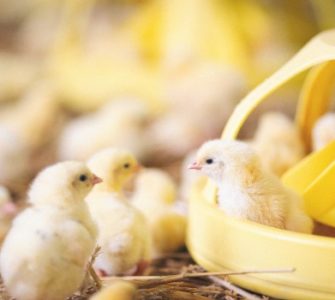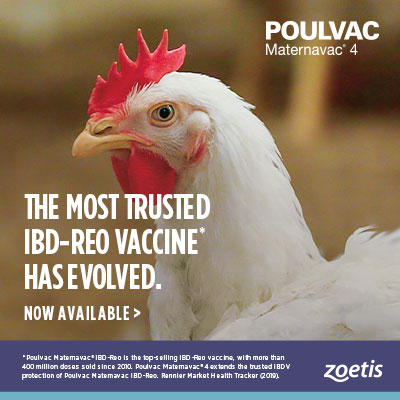Selection of IBV GA 08 vaccine, proper administration can minimize reactions
An interview with Kalen Cookson, DVM, MAM, Director of Clinical Research, Zoetis
Q: It’s widely known that live infectious bronchitis virus (IBV) vaccines can sometimes lead to adverse reactions that interfere with broiler performance. What’s the cause?
KC: A mild respiratory reaction is to be expected.1 All IBV vaccines, including those that protect against IBV variant Georgia 2008 (GA 08), provide a controlled dose of the pathogen to stimulate immunity. With field vaccination, reactions generally occur 2 or 3 days later, last a few days, then subside. With hatchery vaccination, peak reactions usually occur at 7 to 10 days. In fact, if there’s no reaction, it’s likely the vaccine isn’t stimulating immunity.
Q: What constitutes a severe vaccine reaction?
KC: The reaction is harsh and often prolonged. Birds may develop airsacculitis as well as secondary Escherichia coli infections. Poor weight gain, feed conversion and flock uniformity can occur and, sometimes, mortality.2
Q: Can severe reactions be avoided?
KC: It helps to use an IBV vaccine that “takes” well and doesn’t persist too long. Generally, you can tell if a vaccine is persisting when reactions last longer than expected. When IBV live vaccines persist, they can pass from bird to bird and behave more like a field virus. This is what the industry refers to as a rolling reaction.
Q: Does persistence differ among IBV vaccines?
KC: Arkansas vaccines tend to persist more than other live IBV vaccines.3 It’s possible some of them don’t take at a high rate soon after vaccination. This can result in rolling reactions and may even affect the birds’ ability to clear other IBV vaccines they receive.
Q: What else can lead to excessive or persistent reactions?
KC: A high bacterial load in the hatchery can result in what I call smoldering air sacs, which can predispose birds to secondary E. coli infection. Obviously, if broilers already have a respiratory infection, vaccinating with a respiratory vaccine can lead to a more intense reaction and airsacculitis.
Good brooding management is important to prevent stress, which can also contribute to excessive vaccine reactions. That means proper water sanitation and litter management.
Q: Can spray administration technique at the hatchery lead to excessive reactions?
KC: It can if the spray pressure’s too high, leading to very fine particles that penetrate far into the lungs. Or if spray coverage isn’t uniform, you can end up with chickens over- and under-vaccinated in the same chick box, which can also result in rolling reactions. It’s helpful to run an empty chick tray through the sprayer 2 to 3 times a day to check coverage.
Q: Do you have any tips for producers on the number of IBV serotypes they should apply in the hatchery?
KC: It depends on the field situation. If the hatchery is in a region that doesn’t have a high presence of variant IBV, birds are often vaccinated with IBV Massachusetts plus maybe IBV Connecticut. In higher challenge areas, up to three serotypes may be used. We don’t recommend more than three at a time. Otherwise you probably can’t expect a consistent flock response.
Q: Does Poulvac® Bron GA 08 require any special handling to maintain efficacy or prevent reactions?
KC: It’s a frozen vaccine. If it starts to thaw before administration, be sure to keep it cool. Once it starts warming, the titer starts to drop. Hatcheries need to remove the vaccine from thaw baths just before the last crystals melt. If the vaccine needs to be transported to a farm, vaccine vials can be kept on ice in a cooler.
1 Butcher G, et al. Newcastle and Infectious Bronchitis Vaccine Reactions in Commercial Broilers. University of Florida IFAS Extension. Publication #VM132.
2 Ibid.
3 Jackwood MW, et al. Infectious bronchitis virus field vaccination coverage and persistence of Arkansas-type viruses in commercial broilers. Avian Dis. 2009 Jun;53(2):175-83.
TOOLBOX, Issue 10
Toolbox is a series of interviews with veterinarians and other technical specialists about their experiences managing antimicrobials, vaccines and other tools for poultry health. It is produced by the editors of Poultry Health Today on behalf of the US Poultry Business of Zoetis.
BIO-00175
Jan 2019
Posted on December 15, 2018















